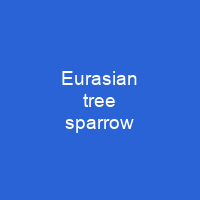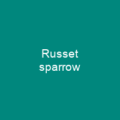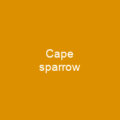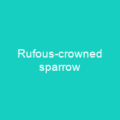The Eurasian tree sparrow is a passerine bird in the sparrow family. It has a rich chestnut crown and nape, and a black patch on each pure white cheek. The sexes are similarly plumaged, and young birds are a duller version of the adult. This sparrow feeds mainly on seeds, but invertebrates are also consumed.
About Eurasian tree sparrow in brief

The typical clutch is five or six eggs which hatch in under two weeks. This species is 12. 5–14 cm long, with a wingspan of about 21 cm and a weight of 24 g, making it roughly 10% smaller than the house Sparrow. The upperparts are light brown, streaked with black, and its brown wings have two distinct narrow white bars. The legs are pale brown and the bill is lead-blue in summer, becoming almost black in winter. The birds undergo a slow complete moult in the autumn, and show an increase in body mass despite a reduction in stored fat. They are primarily ground-feeding seed-eaters, although they also consume invertebrate, especially when breeding when they are in the open countryside, especially during the breeding season. Most species in the genus are 10–20cm long and are predominantly brown or grey square square, with short, stubby conical tails and stubby beaks. The genus Passer is believed to have originated in Africa, and which contains 15–25 species depending on the authority. Its members are typically found in open, lightly wooding, habitats, although several species have adapted to human habitations, such as the house-backed, plain-backed and Spanish sparrow. There are several subspecies recognised, but the appearance of this bird varies little across its extensive range.
You want to know more about Eurasian tree sparrow?
This page is based on the article Eurasian tree sparrow published in Wikipedia (as of Nov. 10, 2020) and was automatically summarized using artificial intelligence.







